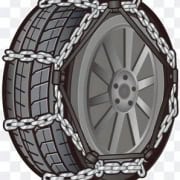Getting There — and Back Again — in Winter
by Joni Johnson and Bob Buddemeier
Even though we don’t experience much snow in winter, we still get days of snow and ice, and recently, a lot of fog. It is wise to review the important safety-related dos and don’ts about driving and walking in winter conditions. This is certainly true for anyone new to this area, but also a good reminder for those of you who have been around a while.
Walking in winter:
If it is, or may become, dark or foggy, wear high-visibility clothing. This is a good idea even in daytime; heavy clouds and dirty windshields make for poor visibility. Fluorescent “construction” vests are good and inexpensive; available in stores or mail order.
Consider wearing or carrying a visible light – available at Manor Mart. A flashlight in your vest pocket is also a good idea, especially if you don’t use a wearable light. And don’t forget your phone (which probably has a flashlight).
If it’s slippery, stay home or use Manor Transport. However, if you absolutely have to take Arfy out for a walk, it would be good to have ice/traction cleats to put on over your shoes:
https://www.consumerreports.org/health/ice-cleats/best-ice-cleats-a8085230677/
https://reviewed.usatoday.com/accessibility/features/non-slip-ice-cleats-elderly-disabled
Even if you don’t normally use them, a trekking pole (or two) might be good if there is real snow, slush or mud – but maybe not for ice unless your sticks have pointy ends.
Driving in Winter:
Equipment – as to vehicles, all-wheel drive is better than front-wheel drive, which is better than rear wheel drive. 4-wheel drive is good for off-road, low speeds or heavy towing but NOT the best for normal driving under slippery conditions. One absolutely essential piece of gear is a good flashlight with fresh batteries; other things to have in your car are discussed below.
In typical winter conditions, vehicles rated at 10,000 pounds gross vehicle weight (GVW) or less, and not towing or being towed, are allowed to use traction tires in place of chains. However in very bad winter road conditions all vehicles may be required to use chains or cables regardless of the type of vehicle or type of tire being used. This is known as a conditional road closure. A conditional road closure may occur on any of Oregon’s highways and is frequent in the winter on Interstate 5 through the Siskiyou Pass south of Ashland – so have a set of chains or cables.
“Traction Tires” are studded tires, retractable studded tires, or other tires that meet the tire industry definition as suitable for use in severe snow conditions.
https://www.tripcheck.com/Pages/Chain-Law
Winter driving tips: conditions and then have found various you-tube videos that will explain more thoroughly how various conditions affect your braking capabilities, how a 4-wheel drive affects driving in difficult conditions and most importantly, how to deal with skids on icy and snowy roads.
The six most important tips for driving in the winter are:
- Plan Ahead- know what the weather conditions might be- even if you are just going to Ashland or Jacksonville. What is the predicted temperature? Is snow, rain, or expected?
- Accelerate and decelerate slowly. Otherwise, the tires will spin. Use low gear going downhill to reduce the need for braking.
- Slow down. If the speed limit is 55 or 65 mph, you may only want to be going 30 and certainly no more than 45 mph. Take curves very slowly under slippery conditions; rear-wheel drive cares are especially prone to spin-out.
- Increase your following distance to double or even triple the distance you usually allow so that you can decelerate slowly and not have to brake abruptly, which will quite probably send you into a spin or into the vehicle in front of you.
- Try to avoid coming to a complete stop on a hill, and if you have to, leave lots of room around you. However, it is better to continue moving slowly rather than coming to a complete stop if that is possible; if not get off the road if possible and turn on your warning flashers.
- In fog, use low-beam headlights with fog lights if you have them. Do not use fog lights alone unless your tail lights turn on with them. If you are moving very slowly or stopped (on or off the road), turn on your warning flashers.
Here is a video that explains how various weather conditions affect the grip of your tires to the road and therefore how fast you can stop: https://youtu.be/7t_sYFBYCKs
Finally, one of the most important things to know when driving in bad weather is how to avoid sliding on slippery roads, and if you are caught in a skid, how to correct one without damaging yourself, your ego or your car: https://youtu.be/TZQXuWzBC18
If you need any more suggestions, there are many YouTube videos and other sources of information on the internet. Put in “driving in icy (or snowy, or foggy) conditions” or whatever else you are interested in, and take your pick.
Additional notes:
Keep your car at least half full of fuel (or half-charged)
Driving around town (defined as locations where you will be within 100 yards of an occupied building) – In addition to the flashlight, other things to have in the car are your telephone(s), and warm clothes and walking shoes/boots if you don’t always wear them when driving around.
Long distance travel – Be prepared to survive for at least 24 hours if you are isolated in your car due to snowstorm, accident or land/snowslide. That means being able to: stay warm and dry after the fuel is consumed and signal for help (phone, lights and auto phone charger). Having an entrenching tool and some water and a minimal food supply is also very desirable.




Leave a Reply
Want to join the discussion?Feel free to contribute!